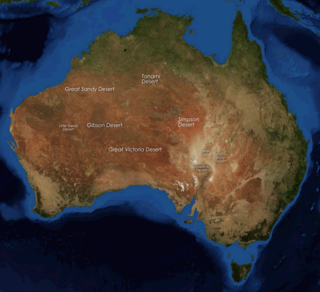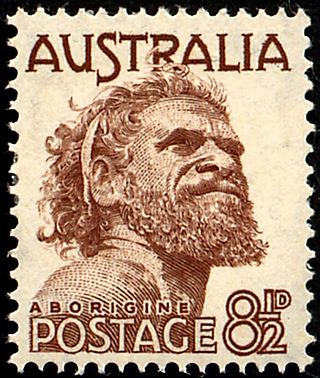
The Great Sandy Desert is an interim Australian bioregion, located in the northeast of Western Australia straddling the Pilbara and southern Kimberley regions and extending east into the Northern Territory. It is the second largest desert in Australia after the Great Victoria Desert and encompasses an area of 284,993 square kilometres (110,036 sq mi). The Gibson Desert lies to the south and the Tanami Desert lies to the east of the Great Sandy Desert.

The Warlpiri, sometimes referred to as Yapa, are a group of Aboriginal Australians defined by their Warlpiri language, although not all still speak it. There are 5,000–6,000 Warlpiri, living mostly in a few towns and settlements scattered through their traditional land in the Northern Territory, north and west of Alice Springs (Mparntwe). About 3,000 people still speak the Warlpiri language. The word "Warlpiri" has also been romanised as Walpiri, Walbiri, Elpira, Ilpara, and Wailbri.

The Warlpiri language is spoken by close to 3,000 of the Warlpiri people from the Tanami Desert, northwest of Alice Springs, Central Australia. It is one of the Ngarrkic languages of the large Pama–Nyungan family and is one of the largest Aboriginal languages in Australia in terms of number of speakers. One of the most well-known terms for The Dreaming, Jukurrpa, derives from Warlpiri.
Yuendumu is a town in the Northern Territory of Australia, 293 km (182 mi) northwest of Alice Springs on the Tanami Road, within the Central Desert Region local government area. It ranks as one of the larger remote communities in central Australia, and has a thriving community of Aboriginal artists. It is home to Pintubi Anmatjere Warlpiri (PAW) Media, which produced the TV series Bush Mechanics.

The Barkly Tableland is a region in the Central East if the Northern Territory, extending into Western Queensland. The region was named after Sir Henry Barkly. The epithet "Tableland" is inaccurate, since the region is neither elevated relative to adjacent landforms, nor are the boundaries marked by a distinct change in elevation.

The deserts of Australia or the Australian deserts cover about 1,371,000 km2 (529,000 sq mi), or 18% of the Australian mainland, but about 35% of the Australian continent receives so little rain, it is practically desert. Collectively known as the Great Australian desert, they are primarily distributed throughout the Western Plateau and interior lowlands of the country, covering areas from South West Queensland, Far West region of New South Wales, Sunraysia in Victoria and Spencer Gulf in South Australia to the Barkly Tableland in Northern Territory and the Kimberley region in Western Australia.

Newhaven Wildlife Sanctuary, once a cattle station known as Newhaven Station, is an Australian nature reserve. It lies around 300–400 kilometres (186–249 mi) north-west of Alice Springs in the Northern Territory of Australia. It is jointly operated by Birds Australia and the Australian Wildlife Conservancy.

Balgo, previously Balgo Hills and Balgo Mission, is a community in Western Australia that is linked with both the Great Sandy Desert and the Tanami Desert. The community is in the Shire of Halls Creek, off the Tanami Road, and was established by German missionaries in 1939. In the 2021 census Balgo's population numbered 430.

Olive Muriel Pink was an Australian botanical illustrator, anthropologist, gardener, and activist for Aboriginal rights who spent much of her life in Central Australia.

Gwoya Tjungurrayi, also spelt Gwoja Tjungarrayi, Gwoya Jungarai, and Gwoya Djungarai, and also known by his nickname One Pound Jimmy, is known for being the first Aboriginal person to be featured on an Australian postage stamp, in 1950, although his name was not used to describe the image on the stamp. A survivor of the 1928 Coniston massacre in the Northern Territory, he later became an elder and lawman of his people. The name Gwoya, is a non-Indigenous rendering of the Anmatyerr word 'Kwatye', meaning 'water' or 'rain'.
Tanami Downs is an Indigenous Australian-owned cattle station in the Northern Territory of Australia.
Biddy Rockman Napaljarri is a Walpiri-speaking Indigenous artist from Australia's Western Desert region. She has been painting since 1986, and her work is in the collection of the National Gallery of Victoria.
Peggy Rockman Napaljarri is a Warlpiri-speaking Indigenous artist from Australia's Western Desert region. Born on what is now Tanami Downs pastoral station in the Northern Territory, she learned English when working as a child with a white mining family; Peggy Rockman and her family were subsequently relocated by government authorities to Lajamanu, a new community west of Tennant Creek. Peggy Rockman is one of the traditional owners of Tanami Downs.
Mona Rockman Napaljarri is a Warlpiri-speaking Indigenous artist from Australia's Western Desert region. Her paintings and pottery are held in the collection of the National Gallery of Victoria.
Aboriginal Australian kinship comprises the systems of Aboriginal customary law governing social interaction relating to kinship in traditional Aboriginal cultures. It is an integral part of the culture of every Aboriginal group across Australia, and particularly important with regard to marriages between Aboriginal people.
Supplejack Downs, also known as Suplejack Downs, is a pastoral lease operating as a cattle station in the Northern Territory of Australia.
Mount Doreen Station is a 7,337-square-kilometre (2,833 sq mi) pastoral lease operating as a cattle station in the Northern Territory of Australia.
Nyirripi is a community in the Southern Tanami Ward of the Central Desert Region in the Northern Territory of Australia. The town is approximately 440 kilometres from Alice Springs, with the drive taking 5 to 6 hours. As of 2021, the town's population was 251 people.
Megan Joan Fleming, is an Australian/New Zealand poet, non-fiction writer and academic.
Allan Arthur Davidson was an Australian mining engineer, prospector and explorer who undertook some of his most notable work in the Northern Territory in his explorations of the Tanami Desert.







